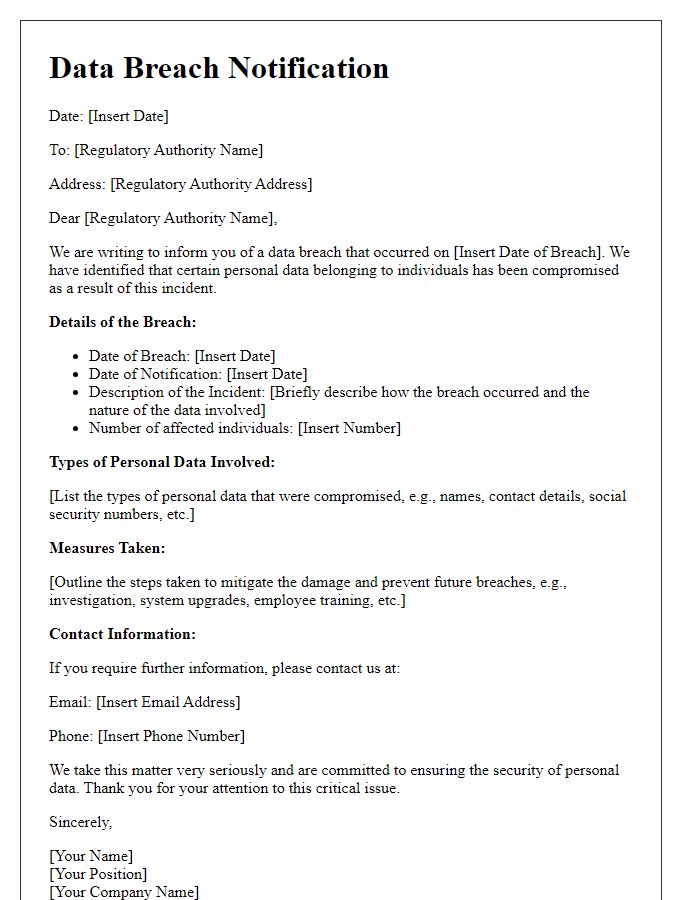In today's digital age, the threat of data breaches looms larger than ever, impacting individuals and organizations alike. Understanding how to effectively communicate about a data breach can make all the difference in maintaining trust with your stakeholders. This letter template will guide you through the essential components needed to address such a sensitive issue transparently and responsibly. Join us as we explore best practices for notifying affected parties and ensuring they feel informed and supported.

Legal Compliance Requirements
Data breaches can have significant legal implications, particularly regarding compliance with regulations such as the General Data Protection Regulation (GDPR) or the California Consumer Privacy Act (CCPA). Organizations must notify affected individuals within specific time frames--72 hours for GDPR--which requires careful monitoring and prompt reporting. Details such as the nature of the data (personal identifiable information like Social Security numbers, credit card information), the potential impact on affected individuals, and details on mitigation efforts must be included in the notification. Additionally, regulatory bodies, such as the Federal Trade Commission (FTC) in the United States, often require documentation of the breach and the response, ensuring organizations adhere to legal requirements to avoid significant fines and reputational damage.
Detailed Incident Description
A data breach notification must include a detailed incident description, outlining the specific events that led to the breach. On September 15, 2023, our cybersecurity team detected unauthorized access to our database, containing sensitive personal information of approximately 50,000 customers. Attackers exploited a vulnerability in our web application, allowing them to bypass security measures. The breach compromised data including full names, email addresses, and cryptographic password hashes, stored in our MySQL database. Internal investigation revealed that the breach was initiated through a SQL injection attack, which manipulated our server to retrieve data. We immediately engaged forensic specialists to assess the situation and enhance security protocols. Affected individuals were informed, and monitoring services were offered to safeguard against identity theft.
Affected Data Information
A data breach notification must include specific details about the affected data. The breach may involve personal identification information collected from individuals, including names, email addresses, Social Security numbers, and financial information such as credit card numbers and bank account data. Additionally, if health information was compromised, details related to medical records, treatment histories, and insurance policy numbers could also be included. The breach may have occurred in a specific location, such as a database server at a corporate office in New York City or an online cloud storage service. It is vital to specify the date of the breach, the number of affected individuals (for example, over 10,000 records), and any unauthorized access that occurred between compromised dates. These elements establish context for impacted individuals and help them assess the potential ramifications of the breach.
Potential Risk Mitigation Steps
A data breach notification aims to inform affected individuals of potential risks associated with compromised personal information. Steps to mitigate these risks include regularly monitoring credit reports (available through agencies like Equifax, Experian, and TransUnion), enabling fraud alerts, and considering identity theft protection services such as LifeLock or IdentityGuard. Additionally, it is crucial to change passwords for online accounts (especially those linked to financial institutions), implement two-factor authentication where possible, and maintain vigilance against phishing attempts. Individuals should also be aware of local laws on data protection (like the California Consumer Privacy Act, CCPA) which may influence their rights in response to the breach.
Contact Information for Assistance
In cases of data breaches, organizations must provide clear contact information for assistance to affected individuals. This typically includes a dedicated phone number where representatives are trained to address concerns about identity theft and fraud detection. Additionally, an email address specifically for breach inquiries should be included to allow for secure and documented communication. A mailing address can also be provided for individuals preferring traditional correspondence. It's important to ensure that this contact information is easily accessible and prominently displayed in official notifications, as timely assistance can help mitigate potential damage from the breach and restore trust among customers.
Letter Template For Addressing Data Breach Notification Samples
Letter template of Data Breach Notification for Cybersecurity Advisories













Comments